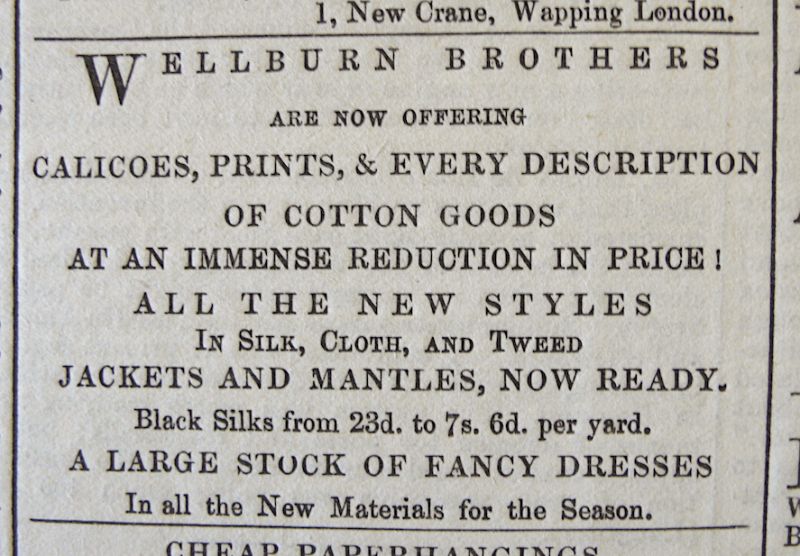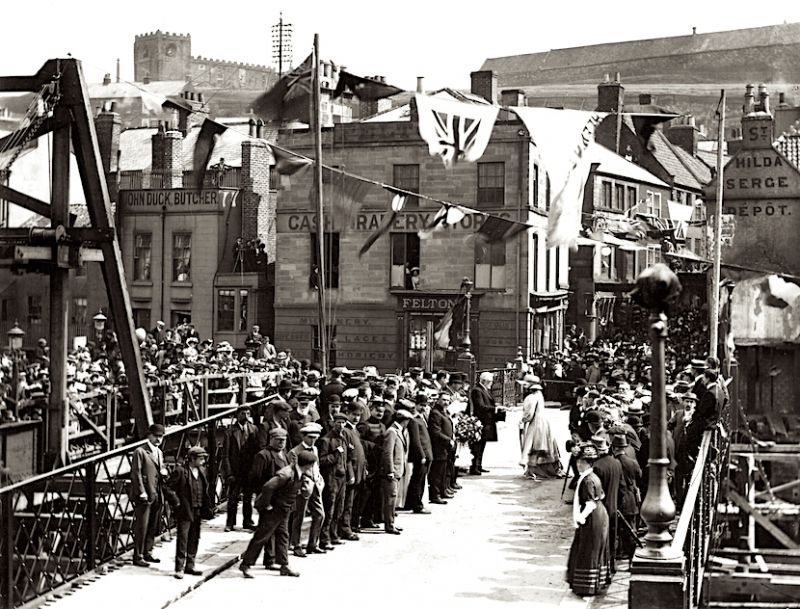ikfoundation.org
The IK Foundation
Promoting Natural & Cultural History
Since 1988


 Crowdfunding Campaign
Crowdfunding Campaignkeep knowledge open, connected, and growing on this textile history resource...
REDUCED PRICES ON TEXTILE GOODS
– Advertising 1855-1914
Drapers, tailors, dressmakers, milliners and other similar shopkeepers could have various reasons for offering goods at a lower price than normal. Advertisements giving evidence for this type of information to the customers were often mentioned in the terms of “reduced prices” or “special value” – whilst “sales” seldom were associated with a lowering of the price at this period according to adverts in Whitby Gazette. This essay is based on my research for The Textile History of Whitby 1700-1914 and will further exemplify in what way a couple of traders tried to sell their stock of garments, cloths, interior textiles, accessories etc for the best possible price to local customers and visiting tourists alike.
 The Linen & Woollen drapers Wellburn Brothers of Bridge Street (1857-1914) placed small advertisements regularly, either to announce a new item available, a large stock of a particular product or a sale at reduced prices. In spring of 1860 for example, they sold a selection of their goods ‘At an immense reduction in price!’. (Whitby Museum, Library & Archive). Photo: Viveka Hansen.
The Linen & Woollen drapers Wellburn Brothers of Bridge Street (1857-1914) placed small advertisements regularly, either to announce a new item available, a large stock of a particular product or a sale at reduced prices. In spring of 1860 for example, they sold a selection of their goods ‘At an immense reduction in price!’. (Whitby Museum, Library & Archive). Photo: Viveka Hansen.One recurring reason for reducing prices on various goods in these early advertisements was that a shop owner closed or retired from their business. One such representative case was the millinery Misses Noble & Wilson, which was already established by 1860 and continued to advertise until 1878. This establishment for ladies was situated in West Whitby on Bellevue Terrace, and they advertised the latest fashions for hats in every imaginable material. On 23 March of their final year, they announced: ‘Notice, Retiring from Business and Selling off... Whole of their Stock at Greatly reduced prices.’
Another cause for reducing prices was to sell off unwanted stock at the end of the summer or winter seasons. One such example was the draper David Hume (1895-1909) at Baxtergate, who had earlier worked for the cash-drapers R. Gray & Co. David Hume regularly advertised till 1909, concentrating mainly on ladies’ clothes and accessories. For example, on 25 August 1899, he had on offer a ‘Surplus Stock of Mantles, Jackets, Capes, Coats & Skirts... Remaining Stock of Blouses, Shirts, Ties, Collars, Fichus, Ostrich Feather Boas, Sunshades, Skirts, Sun hats & Bonnets, Millinery, &c. All specially reduced.’
 Detailed study by an unknown photographer showing the opening of the Swing Bridge in 1909, leading up to Bridge Street. This area was a “textile district” for the whole advertising period from 1855 to 1914 – and earlier – including several of the long-established draperies of Whitby. (Courtesy of: Whitby Museum, Photographic Collection).
Detailed study by an unknown photographer showing the opening of the Swing Bridge in 1909, leading up to Bridge Street. This area was a “textile district” for the whole advertising period from 1855 to 1914 – and earlier – including several of the long-established draperies of Whitby. (Courtesy of: Whitby Museum, Photographic Collection).If a business was unsuccessful despite its own attempts to sell off surplus clothing, fabrics, carpets, etc – it was possible to use an auctioneer for such goods. Mr Flintoft was one such trader advertising in Whitby Gazette in 1870, who held auctions in the Victoria Room at the Angel Hotel, where he sold both ‘Drapery Goods’ and ‘Household furniture’ on various occasions. In the case of drapery goods, the sale was not always by auction, but sometimes could be sold directly in an event that could last five days, during which several drapers could leave goods that needed to be disposed of before new stock could be taken in. Since this type of sale or auction of drapery goods was repeated over the next two decades, it must have proved a good way for sellers to rid themselves of large surplus stocks while giving buyers a chance to acquire quality textiles at heavily reduced prices.
![This advert from December 1875 in Whitby Gazette gives an example of the more unusual term “Sale” when a shopkeeper announced reduced prices. Marshall & Snelgrove [later part of Debenhams] was a well-known London firm at Oxford Street at this period, but had among other places also a branch at St. Nicholas Street in Scarborough. (Whitby Museum, Library & Archive). Photo: Viveka Hansen.](https://www.ikfoundation.org/uploads/image/3-reduced-prices-marshall-snelgrove-800x648.jpg) This advert from December 1875 in Whitby Gazette gives an example of the more unusual term “Sale” when a shopkeeper announced reduced prices. Marshall & Snelgrove [later part of Debenhams] was a well-known London firm at Oxford Street at this period, but had among other places also a branch at St. Nicholas Street in Scarborough. (Whitby Museum, Library & Archive). Photo: Viveka Hansen.
This advert from December 1875 in Whitby Gazette gives an example of the more unusual term “Sale” when a shopkeeper announced reduced prices. Marshall & Snelgrove [later part of Debenhams] was a well-known London firm at Oxford Street at this period, but had among other places also a branch at St. Nicholas Street in Scarborough. (Whitby Museum, Library & Archive). Photo: Viveka Hansen.Sources:
- Hansen, Viveka, The Textile History of Whitby 1700-1914 – A lively coastal town between the North Sea and North York Moors, London & Whitby 2015 (Chapter III).
- Whitby Gazette, 1855-1914 (Whitby Museum, Library & Archive).
- Whitby Museum, Photographic Collection (studies of local photographs).
More in Books & Art:
Essays
The iTEXTILIS is a division of The IK Workshop Society – a global and unique forum for all those interested in Natural & Cultural History.
Open Access Essays by Textile Historian Viveka Hansen
Textile historian Viveka Hansen offers a collection of open-access essays, published under Creative Commons licenses and freely available to all. These essays weave together her latest research, previously published monographs, and earlier projects dating back to the late 1980s. Some essays include rare archival material — originally published in other languages — now translated into English for the first time. These texts reveal little-known aspects of textile history, previously accessible mainly to audiences in Northern Europe. Hansen’s work spans a rich range of topics: the global textile trade, material culture, cloth manufacturing, fashion history, natural dyeing techniques, and the fascinating world of early travelling naturalists — notably the “Linnaean network” — all examined through a global historical lens.
Help secure the future of open access at iTEXTILIS essays! Your donation will keep knowledge open, connected, and growing on this textile history resource.
been copied to your clipboard




– a truly European organisation since 1988
Legal issues | Forget me | and much more...
You are welcome to use the information and knowledge from
The IK Workshop Society, as long as you follow a few simple rules.
LEARN MORE & I AGREE







